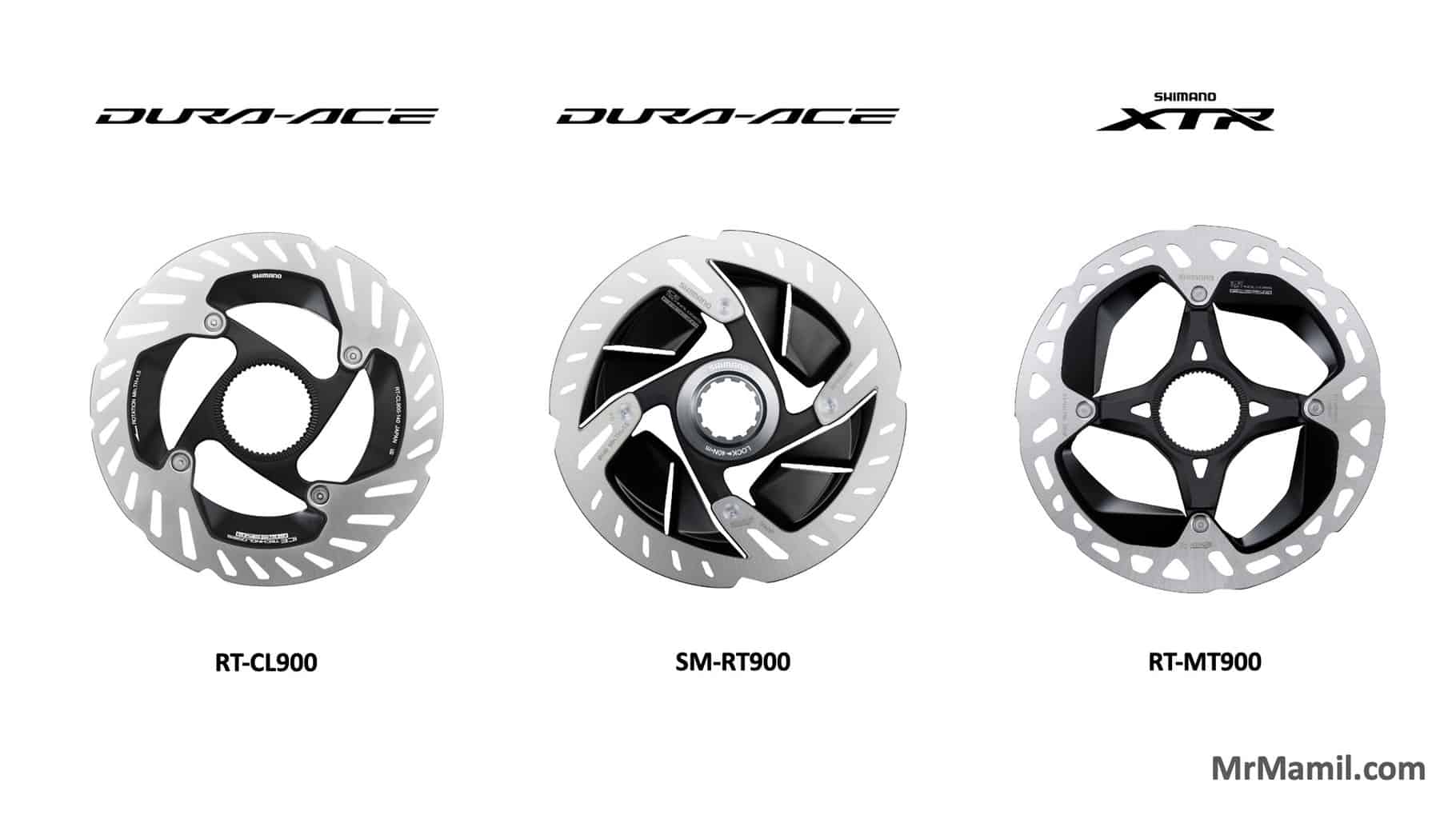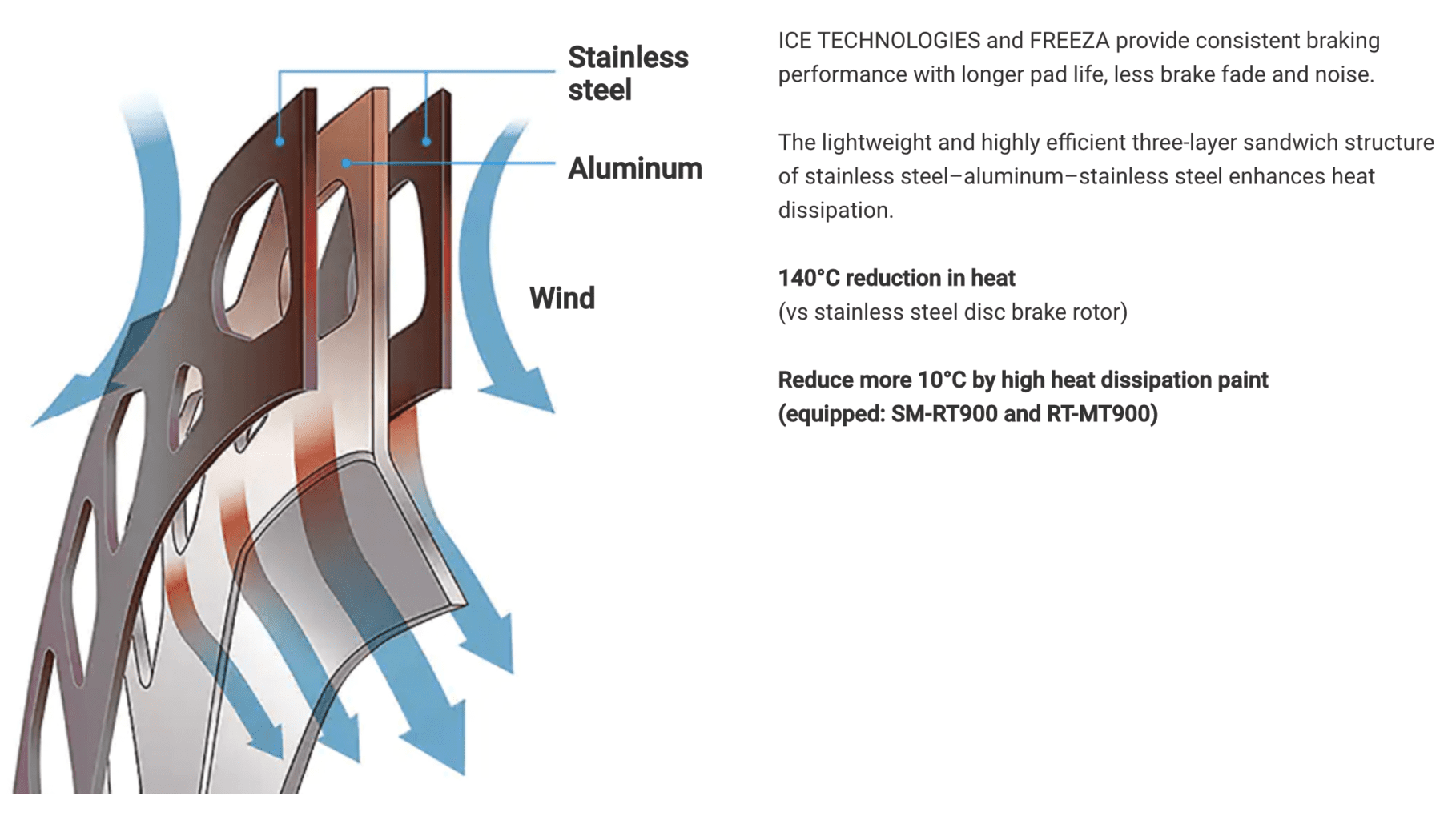Ever wondered about the differences between the Shimano Dura-Ace (RT-CL900) and XTR (RT-MT900) disc brake rotors?
Drawing from my experience using these rotors and detailed research, I’ll compare these top-of-the-line Shimano rotors, highlighting the differences in design, performance characteristics, applications, and advantages.
Shimano rotor models
The Shimano Dura-Ace and XTR rotors have 900 at the end, indicating they’re Shimano’s top-of-the-line disc rotors. Pay attention to the letters before the 900.
The table below shows all the available Shimano Dura-Ace and XTR rotors. All three rotors are cross-compatible with each other.
Rotor design

The rotors use the Shimano ICE and Freeza Technologies for efficient heat dissipation. The main difference lies in their design.
Dura-Ace rotor design (RT-CL900, SM-RT900)
Both Dura-Ace rotors have four arms that curve with the wheel rotation connecting to the braking surface.
The Dura-Ace RT-CL900 rotor only has cooling fins where needed most, with larger gaps between the fins and arms. With this design, the cooling and heat dissipation may be slightly compromised, but generally, this is not an issue as the disc brakes aren’t designed to be continuously dragged down a descent.
On the other hand, the Dura-Ace SM-RT900 rotor has larger cooling fins, making them look more solid and aero.
XTR rotor design (RT-MT900)
The XTR rotor has four arms at a 90º angle for 140mm and 160mm size and five arms for 180mm and 203mm rotors to provide additional strength.
The cooling fins are placed where needed most, with larger gaps between the fins and arms.
Braking performance
With the difference in rotor designs, many cyclists claimed that the XTR rotors (RT-MT900) have a slight edge in braking performance. The pros use them on the long and steep descends in the Tour de France, where the braking performance is tested to its limits.
Besides that, many cyclists also assumed they should perform better because they’re designed for mountain bikes.
From my experience of using all three rotor models, quantifying these is hard. The fact that Shimano updated the Dura-Ace (RT-CL900) to resemble the XTR rotor (RT-MT900) indicates that there is some truth in what many cyclists claim,
Rotor weight and sizes
One of the main reasons cyclists, especially the weight weenies, prefer the XTR rotors is because it’s lighter.
Both the Dura-Ace rotors (RT-CL900 and SM-RT900) have the same overall weight of 210g with a 160mm front and 140mm rear combination. The Dura-Ace rotors are available in 140mm and 160mm sizes.
The XTR rotors (RT-MT900) are available in 140, 160, 180, and 203mm. The 180 and 203mm rotors will not fit onto a road bike.
A road bike with a 160mm front and 140mm rear rotor could save up to 20g just by switching to XTR rotors.
| Series | Model no. | Rotor size | Weight |
|---|---|---|---|
| Dura-Ace (12-speed) | RT-CL900 | 140mm | 96g |
| Dura-Ace (12-speed) | RT-CL900 | 140mm | 114g |
| Dura-Ace (11-speed) | SM-RT900 | 140mm | 94g |
| Dura-Ace (11-speed) | SM-RT900 | 160mm | 116g |
| XTR | RT-MT900 | 140mm | 85g |
| XTR | RT-MT900 | 160mm | 106g |
| XTR | RT-MT900 | 180mm | 132g |
| XTR | RT-MT900 | 203mm | 150g |
What are the similarities between these rotors?

We’ve discussed the differences, but there are also some similarities between them that you should also know about.
- Shimano’s top-of-the-line rotors. The Dura-Ace is for road bikes, and XTR is for mountain bikes, although they’re cross-compatible.
- ICE Freeza Technologies is Shimano’s latest technology to cool down the rotors for consistent performance, especially during hard braking. The rotors have a three-layer sandwich structure; stainless steel, aluminum, and stainless steel. The Freeza is where the aluminum extends into the cooling fins for better heat dissipation.
- Centerlock (AFS). Both are Centerlock rotors and will fit all of the disc brake wheelsets. Older wheels that use a 6-bolt pattern will need an additional adapter.
- Brake pads. They work with Shimano’s and other third-party road bike brake pads for the R9200, R9170, R8100, and R8070 calipers. Brake pad compatibility is the function of the brake calipers, not the rotors.
Pricing and availability
Pricing-wise, the Dura-Ace and XTR rotors differ between $5 to $10.
The challenge many cyclists face is the availability of the XTR 140mm rotors, which are hard to come by since not many mountain bikes use them.
| Series | Rotor size | Retail price (USD) | Available at |
|---|---|---|---|
| Dura-Ace (RT-CL900) | 140mm | $86 | Amazon |
| Dura-Ace (RT-CL900) | 140mm | $86 | Amazon |
| Dura-Ace (SM-RT900) | 140mm | $82 | Amazon |
| Dura-Ace (SM-RT900) | 160mm | $82 | Amazon |
| XTR (RT-MT900) | 140mm | $80 | Amazon |
| XTR (RT-MT900) | 160mm | $80 | Amazon |
| XTR (RT-MT900) | 180mm | $85 | Amazon |
| XTR (RT-MT900) | 203mm | $85 | Amazon |
Shimano disc rotors FAQ
What is the difference between RT-MT800 vs RT-MT900 rotors?
The RT-MT800 vs RT-MT900 are rotors launched with the 11-speed Shimano Di2 groupsets. Both are the same except for the cooling fin colors.
| Comparison | RT-MT800 | RT-MT900 |
|---|---|---|
| Groupset | Shimano Ultegra (R8000) | Shimano Dura-Ace (R9100) |
| Cooling fin color | Silver | Black |
| ICE Technologies | Yes | Yes |
| ICE Freeza Technologies | Yes | Yes |
| Rotor weight (140mm) | 88g (140mm) 108g (160mm) | 88g (140mm) 108g (160mm) |
| Retail price (USD) | $61 | $86 |
What is the difference between RT-CL800 vs RT-CL900 rotors?
The RT-CL800 vs RT-CL900 are the latest rotors from Shimano, launched with the 12-speed Shimano Di2 groupsets. Both are the same except for the cooling fin colors.
| Comparison | RT-CL800 | RT-CL900 |
|---|---|---|
| Rotor model | Shimano Ultegra (R8100) | Shimano Dura-Ace (R9200) |
| ICE Technologies | Yes | Yes |
| ICE Freeza Technologies | Yes | Yes |
| Rotor weight | 95g (140mm) 113g (160mm) | 95g (140mm) 113g (160mm) |
| Rotor price (USD) | $61 | $86 |

Alex Lee is the founder and editor-at-large of Mr. Mamil. Coming from a professional engineering background, he breaks down technical cycling nuances into an easy-to-understand and digestible format here.
He has been riding road bikes actively for the past 12 years and started racing competitively in the senior category during the summer recently.